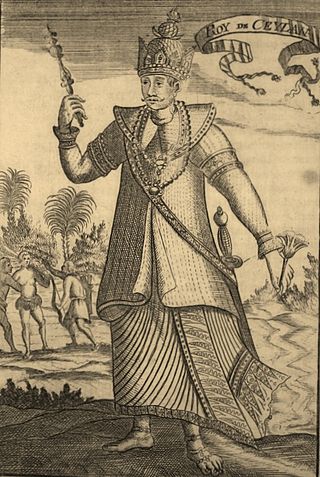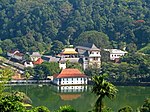
The history of Sri Lanka is unique because its relevance and richness extend beyond the areas of South Asia, Southeast Asia and the Indian Ocean. The early human remains which were found on the island of Sri Lanka date back to about 38,000 years ago.

Colombo is the executive and judicial capital and largest city of Sri Lanka by population. The Colombo metropolitan area is estimated to have a population of 5.6 million, and 752,993 within the municipal limits. It is the financial centre of the island and a tourist destination. It is located on the west coast of the island and adjacent to the Greater Colombo area which includes Sri Jayawardenepura Kotte, the legislative capital of Sri Lanka, and Dehiwala-Mount Lavinia. Colombo is often referred to as the capital since Sri Jayawardenepura Kotte is situated within the Colombo metro area. It is also the administrative capital of the Western Province and the district capital of Colombo District. Colombo is a busy and vibrant city with a mixture of modern life, colonial buildings and monuments.

The Kandyan Wars refers generally to the period of warfare between the British colonial forces and the Kingdom of Kandy, on the island of what is now Sri Lanka, between 1796 and 1818. More specifically it is used to describe the expeditionary campaigns of the British Army in the Kingdom of Kandy in 1803 and 1815.

Batticaloa is a major city in the Eastern Province, Sri Lanka, and its former capital. It is the administrative capital of the Batticaloa District. The city is the seat of the Eastern University of Sri Lanka and is a major commercial centre. It is on the east coast, 111 kilometres (69 mi) south of Trincomalee, and is situated on an island. Pasikudah is a popular tourist destination situated 35 km (22 mi) northwest with beaches and flat year-round warm-water shallow-lagoons.

King Rajasinghe II, also known as Rajasingha II, was a Sinhalese King, reigned 1629 – 6 December 1687; seventh king of the Kingdom of Kandy in Sri Lanka. Rajasingha requested aid from the newly formed Dutch East India Company to help expel the Portuguese from the island, which they successfully did in 1656. By this time however it had become clear to the Kandyans that the Dutch not only intended to expel the Portuguese but to replace them as the major colonial power on the island. This transfer of power is also believed to be where the Sinhala idiom / figure of speech “ඉඟුරු දී මිරිස් ගත්තා වාගේ” Inguru di miris gaththa wagay was originated - in reference that the Dutch Rule was much more of a menace to the king and cruel to the people in the island than the Portuguese. From 1645 onwards Rajasingha was engaged in sporadic warfare with his erstwhile allies.

Sri Vikrama Rajasinha, born Kannasamy, was the last of four kings to rule the Kingdom of Kandy in Sri Lanka. Being crowned king in 1798 with the backing of Pilamathalawe Adikaram, his capture by the British in 1815 effectively concluded the 2,300-year Sinhalese monarchy on the island. The Nayak Kings were of Telugu origin and practiced Shaivite Hinduism and were patrons of Theravada Buddhism. The Nayak rulers played a huge role in reviving Buddhism in the island. They spoke Telugu and Tamil, and used Tamil as the court language in Kandy alongside Sinhala.

Dutch Ceylon was a governorate established in present-day Sri Lanka by the Dutch East India Company. Although the Dutch managed to capture most of the coastal areas in Sri Lanka, they were never able to control the Kingdom of Kandy located in the interior of the island. Dutch Ceylon existed from 1640 until 1796.

The Nayaks of Kandy, also known as the Kandyan Nayak Dynasty were the rulers of the Kingdom of Kandy from 1739 to 1815. They were the last dynasty to rule Sri Lanka before its full colonisation by the British. The term "Nayak" is derived from the Sanskrit word Nāyaka, meaning "leader" or "governor."

British Ceylon, officially British Settlements and Territories in the Island of Ceylon with its Dependencies from 1802 to 1833, then the Island of Ceylon and its Territories and Dependencies from 1833 to 1931 and finally the Island of Ceylon and its Dependencies from 1931 to 1948, was the British Crown colony of present-day Sri Lanka between 1796 and 4 February 1948. Initially, the area it covered did not include the Kingdom of Kandy, which was a protectorate, but from 1817 to 1948 the British possessions included the whole island of Ceylon, now the nation of Sri Lanka.

The Kingdom of Kandy was a monarchy on the island of Sri Lanka, located in the central and eastern portion of the island. It was founded in the late 15th century and endured until the early 19th century.

The Sri Lanka Railway Department is Sri Lanka's railway owner and primary operator. As part of the Sri Lankan government, it is overseen by the Ministry of Transport. Founded in 1858 as the Ceylon Government Railway, it operates the nation's railways and links Colombo with other population centres and tourist destinations.

Vimaladharmasūriya I was a king of Kandy from 1590 to 1604. His reputation was built when he successfully repulsed two major Portuguese offensives on Kandy, the Battle of Danture in 1594 and the Battle of Balana in 1602, in both of which the Portuguese were humiliatingly defeated.

Kirti Sri Rajasinha was the second Nayaka king of Kandy. He was a prince from the Madurai Nayak Dynasty and the brother-in-law of Sri Vijaya Raja Singha. He succeeded his brother-in-law to the throne in 1751.

Vimaladharmasurya II was a peaceful king of Kandy who succeeded his father, Rajasinghe II, on December 7, 1687.
The Battle of Gannoruwa was a battle of the Sinhalese–Portuguese War fought in 1638 between the occupying Portuguese forces and the Sinhalese King's army at Gannoruwa in the District of Kandy, Sri Lanka. The Portuguese had attempted three times without success to capture the Kingdom of Kandy, in order to bring the entire island under their rule. In 1635, Rajasinghe II became the king of Kandy and started negotiations with the Dutch to obtain their help in driving out the Portuguese. The Portuguese hastened their efforts to take Kandy because of this, and Diogo de Melo de Castro, the Portuguese Captain General, tried to provoke the Sinhalese on several occasions.

The Kandyan Treaty of 1638 was a treaty between the Kingdom of Kandy and the Dutch Republic signed by King Rajasinghe II and Dutch Naval Commander Adam Westerwold and Vice Commander Willem Jacobszoon Coster of the Dutch East India Company. The treaty was signed on 23 May, 1638 in Batticaloa. The treaty secured the terms under which the two nations would cooperate in defending the Kandyan Kingdom from the Portuguese.
The Danture campaign comprised a series of encounters between the Portuguese and the Kingdom of Kandy in 1594, part of the Sinhalese–Portuguese War. It is considered a turning point in the indigenous resistance to Portuguese expansion. For the first time in Sri Lanka a Portuguese army was essentially annihilated, when they were on the verge of the total conquest of the island. A 20,000-strong Portuguese army, led by Governor Pedro Lopes de Sousa, invaded Kandy on 5 July 1594. After three months, severely depleted by guerilla warfare and mass desertions, what remained of the Portuguese army was annihilated at Danture by the Kandyans under King Vimaladharmasuriya. With this victory, the Kingdom of Kandy emerged as a major military power; it was to retain its independence, against Portuguese, Dutch, and British armies, until 1815.

Between 1518 and 1658, armed conflict took place between the native Sinhalese and Tamil kingdoms of Sri Lanka, and the Portuguese Empire. It spanned from the Transitional to the Kandyan periods of Sri Lankan history. A combination of political and military moves gained the Portuguese control over most of the island, but their invasion of the final independent kingdom was a disaster, leading to a stalemate in the wider war and a truce from 1621. In 1638 the war restarted when the Dutch East India Company intervened in the conflict, initially as an ally of the Sinhalese against the Portuguese, but later as an enemy of both sides. The war concluded in 1658, with the Dutch in control of about half the island, the Kingdom of Kandy the other half, and the Portuguese expelled.

Sri Lanka–United Kingdom relations, or British-Sri Lankan relations, are foreign relations between Sri Lanka and the United Kingdom.

The Dutch-Kandyan War of 1670–1675 emerged as a result of territorial ambitions on the part of the Dutch, who sought to extend their dominion. The conflict saw French involvement, potentially at Rajasinha's invitation, although they were ultimately ousted. Consequently, the Dutch managed to expand their territorial holdings, successfully achieving their objectives.
















